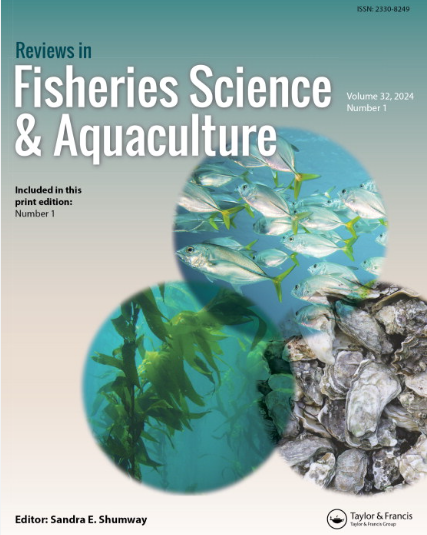A Scoping Review of Aquatic Food Systems during the COVID-19 Pandemic
IF 5.3
1区 农林科学
Q1 FISHERIES
引用次数: 0
Abstract
AbstractThe COVID-19 pandemic created an unprecedented shock to capture fisheries and aquaculture sectors. This scoping review of 670 articles explored the spatial, temporal, and thematic coverage of this event. The search period was January 1, 2020 to February 7, 2022. Articles were mainly peer-reviewed journals (88%) with the remainder from the gray literature (12%). Studies were performed at the global (21%), multi-country (11%), national (45%), and sub-national (23%) levels. Most studies involved primary or secondary data collection (71%) and the remainder were either review articles (17%) or commentaries (12%). Among the studies using primary and secondary data, nearly half (49%) were performed in the first five months of the pandemic (March to July 2020), and 84% within the first year of the pandemic (March 2020–February 2021). There were many studies in South and Southeast Asia, Southern Europe, China, and the United States, and fewer studies in other regions. The pandemic created challenges and opportunities, with heterogeneity in impacts among industrial and small-scale sectors, production methods, geographies, value chains, and by gender. Cumulative impacts from climate change and conflicts contributed to pandemic-related hardships. Increased unemployment and inflation led to rising food insecurity for small-scale producers, fishworkers, and low-income households. Aquatic food intake was more severely affected than other food groups during lockdowns, and it decreased more in low- and middle-income countries than in high-income countries. Responses were diverse, reflecting the capacity and resources of a country, but in general there was unprecedented public support to sustain the private sector (i.e., income support, tax relief, subsidies). As this study focused mainly on the first year of the pandemic, future work is needed to identify which groups exited the pandemic stronger or weaker, what factors enabled some populations to bounce-back, how the crisis affected value chains, and the effectiveness of interventions.Keywords: AquaculturefisheriesCOVID-19livelihoodresiliencesmall-scale AcknowledgmentsWe would like to thank Claire Twose, Johns Hopkins Welch Medical Library, for assisting with the literature review search. We thank Jamie Harding and Mike Milli, Johns Hopkins Center for a Livable Future for assistance in making GIS maps and food systems framework figures, respectively, and Shawn McKenzie at the Johns Hopkins Center for a Livable Future for reviewing the work.Disclosure statementNo potential conflict of interest was reported by the author(s).Data availability statementA bibliography of all references in the literature review and writing of this literature review is available as a Supplement File.Additional informationFundingThis work was funded by the Food and Agriculture Organization of the United Nations, the Johns Hopkins Center for a Livable Future, and the Greater Kansas City Community Foundation.2019冠状病毒病大流行期间水生食品系统范围审查
摘要2019冠状病毒病大流行对捕捞渔业和水产养殖业造成了前所未有的冲击。本文对670篇文章进行了范围审查,探讨了该事件的空间、时间和主题覆盖。搜索期为2020年1月1日至2022年2月7日。文章主要来自同行评议期刊(88%),其余来自灰色文献(12%)。研究在全球(21%)、多国(11%)、国家(45%)和次国家(23%)层面进行。大多数研究涉及主要或次要数据收集(71%),其余为综述文章(17%)或评论(12%)。在使用初级和二级数据的研究中,近一半(49%)是在大流行的前五个月(2020年3月至7月)进行的,84%是在大流行的第一年(2020年3月至2021年2月)进行的。南亚和东南亚、南欧、中国和美国的研究较多,其他地区的研究较少。大流行既带来了挑战,也带来了机遇,对工业和小规模部门、生产方法、地域、价值链和性别的影响各不相同。气候变化和冲突的累积影响加剧了与大流行病有关的困难。失业和通货膨胀加剧导致小规模生产者、渔业工人和低收入家庭的粮食不安全状况加剧。在封城期间,水生食物摄入量受到的影响比其他食物类别更严重,低收入和中等收入国家的下降幅度大于高收入国家。反应是多种多样的,反映了一个国家的能力和资源,但总的来说,维持私营部门的公共支持是前所未有的(即收入支助、税收减免、补贴)。由于本研究主要侧重于大流行的第一年,因此需要开展进一步的工作,以确定哪些群体在大流行后变得更强或更弱,哪些因素使一些人群得以反弹,危机如何影响价值链,以及干预措施的有效性。我们要感谢约翰霍普金斯大学韦尔奇医学图书馆的Claire Twose协助进行文献综述检索。我们感谢约翰霍普金斯大学宜居未来研究中心的Jamie Harding和Mike Milli分别协助制作GIS地图和粮食系统框架图,并感谢约翰霍普金斯大学宜居未来研究中心的Shawn McKenzie对工作的审阅。披露声明作者未报告潜在的利益冲突。数据可用性声明文献综述中所有参考文献的参考书目和本文献综述的写作可作为补充文件。这项工作由联合国粮食及农业组织、约翰霍普金斯未来宜居中心和大堪萨斯城社区基金会资助。
本文章由计算机程序翻译,如有差异,请以英文原文为准。
求助全文
约1分钟内获得全文
求助全文
来源期刊

Reviews in Fisheries Science & Aquaculture
FISHERIES-
CiteScore
25.20
自引率
0.90%
发文量
19
期刊介绍:
Reviews in Fisheries Science & Aquaculture provides an important forum for the publication of up-to-date reviews covering a broad range of subject areas including management, aquaculture, taxonomy, behavior, stock identification, genetics, nutrition, and physiology. Issues concerning finfish and aquatic invertebrates prized for their economic or recreational importance, their value as indicators of environmental health, or their natural beauty are addressed. An important resource that keeps you apprised of the latest changes in the field, each issue of Reviews in Fisheries Science & Aquaculture presents useful information to fisheries and aquaculture scientists in academia, state and federal natural resources agencies, and the private sector.
 求助内容:
求助内容: 应助结果提醒方式:
应助结果提醒方式:


